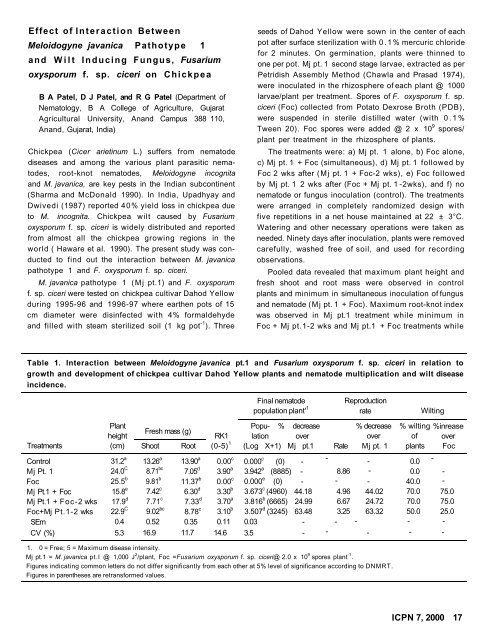Download (1227Kb) - OAR@ICRISAT
Download (1227Kb) - OAR@ICRISAT
Download (1227Kb) - OAR@ICRISAT
Create successful ePaper yourself
Turn your PDF publications into a flip-book with our unique Google optimized e-Paper software.
Effect of Interaction Between<br />
Meloidogyne javanica Pathotype 1<br />
and Wilt Inducing Fungus, Fusarium<br />
oxysporum f. sp. ciceri on Chickpea<br />
B A Patel, D J Patel, and R G Patel (Department of<br />
Nematology, B A College of Agriculture, Gujarat<br />
Agricultural University, Anand Campus 388 110,<br />
Anand, Gujarat, India)<br />
Chickpea (Cicer arietinum L.) suffers from nematode<br />
diseases and among the various plant parasitic nematodes,<br />
root-knot nematodes, Meloidogyne incognita<br />
and M. javanica, are key pests in the Indian subcontinent<br />
(Sharma and McDonald 1990). In India, Upadhyay and<br />
Dwivedi (1987) reported 40% yield loss in chickpea due<br />
to M. incognita. Chickpea wilt caused by Fusarium<br />
oxysporum f. sp. ciceri is widely distributed and reported<br />
from almost all the chickpea growing regions in the<br />
world ( Haware et al. 1990). The present study was conducted<br />
to find out the interaction between M. javanica<br />
pathotype 1 and F. oxysporum f. sp. ciceri.<br />
M. javanica pathotype 1 (Mj pt.1) and F. oxysporum<br />
f. sp. ciceri were tested on chickpea cultivar Dahod Yellow<br />
during 1995-96 and 1996-97 where earthen pots of 15<br />
cm diameter were disinfected with 4% formaldehyde<br />
and filled with steam sterilized soil (1 kg pot -1 ). Three<br />
seeds of Dahod Yellow were sown in the center of each<br />
pot after surface sterilization with 0.1% mercuric chloride<br />
for 2 minutes. On germination, plants were thinned to<br />
one per pot. Mj pt. 1 second stage larvae, extracted as per<br />
Petridish Assembly Method (Chawla and Prasad 1974),<br />
were inoculated in the rhizosphere of each plant @ 1000<br />
larvae/plant per treatment. Spores of F. oxysporum f. sp.<br />
ciceri (Foc) collected from Potato Dexrose Broth (PDB),<br />
were suspended in sterile distilled water (with 0.1%<br />
Tween 20). Foc spores were added @ 2 x 10 9 spores/<br />
plant per treatment in the rhizosphere of plants.<br />
The treatments were: a) Mj pt. 1 alone, b) Foc alone,<br />
c) Mj pt. 1 + Foc (simultaneous), d) Mj pt. 1 followed by<br />
Foc 2 wks after (Mj pt. 1 + Foc-2 wks), e) Foc followed<br />
by Mj pt. 1 2 wks after (Foc + Mj pt. 1 -2wks), and f) no<br />
nematode or fungus inoculation (control). The treatments<br />
were arranged in completely randomized design with<br />
five repetitions in a net house maintained at 22 ± 3°C.<br />
Watering and other necessary operations were taken as<br />
needed. Ninety days after inoculation, plants were removed<br />
carefully, washed free of soil, and used for recording<br />
observations.<br />
Pooled data revealed that maximum plant height and<br />
fresh shoot and root mass were observed in control<br />
plants and minimum in simultaneous inoculation of fungus<br />
and nematode (Mj pt. 1 + Foc). Maximum root-knot index<br />
was observed in Mj pt.1 treatment while minimum in<br />
Foc + Mj pt.1-2 wks and Mj pt.1 + Foc treatments while<br />
Table 1. Interaction between Meloidogyne javanica pt.1 and Fusarium oxysporum f. sp. ciceri in relation to<br />
growth and development of chickpea cultivar Dahod Yellow plants and nematode multiplication and wilt disease<br />
incidence.<br />
Treatments<br />
Control<br />
Mj Pt. 1<br />
Foc<br />
Mj Pt.1 + Foc<br />
Mj Pt.1 + Foc-2 wks<br />
Foc+Mj Pt.1-2 wks<br />
SEm<br />
CV (%)<br />
Plant<br />
height<br />
(cm)<br />
31.2 a<br />
24.0 C<br />
25.5 b<br />
15.8 e<br />
17.9 d<br />
22.9 C<br />
0.4<br />
5.3<br />
Fresh mass (g)<br />
Shoot<br />
13.26 a<br />
8.71 bc<br />
9.81 b<br />
7.42 c<br />
7.71 c<br />
9.02 bc<br />
0.52<br />
16.9<br />
Root<br />
13.90 a<br />
7.05 d<br />
11.37 b<br />
6.30 d<br />
7.33 d<br />
8.78 c<br />
0.35<br />
11.7<br />
RK1<br />
(0-5) 1<br />
0.00 c<br />
3.90 a<br />
0.00 c<br />
3.30 b<br />
3.70 a<br />
3.10 b<br />
0.11<br />
14.6<br />
Final nematode<br />
population plant' 1<br />
Popu- % decrease<br />
lation over<br />
(Log X+1) Mj pt.1<br />
0.000 c (0) -<br />
3.942 a (8885) -<br />
0.000 e (0) -<br />
3.673 c (4960) 44.18<br />
3.816 b (6665) 24.99<br />
3.507 d (3245) 63.48<br />
0.03 -<br />
3.5 -<br />
-<br />
-<br />
Rate<br />
8.86<br />
-<br />
4.96<br />
6.67<br />
3.25<br />
-<br />
Reproduction<br />
rate<br />
% decrease<br />
over<br />
Mj pt. 1<br />
-<br />
-<br />
-<br />
-<br />
44.02<br />
24.72<br />
63.32<br />
1. 0 = Free; 5 = Maximum disease intensity.<br />
Mj pt.1 = M. javanica pt.l @ 1,000 J 2 /plant, Foc =Fusarium oxysporum f. sp. ciceri@ 2.0 x 10 9 spores plant -1 .<br />
Figures indicating common letters do not differ significantly from each other at 5% level of significance according to DNMRT.<br />
Figures in parentheses are retransformed values.<br />
-<br />
% wilting<br />
of<br />
plants<br />
0.0<br />
0.0<br />
40.0<br />
70.0<br />
70.0<br />
50.0<br />
-<br />
-<br />
Wilting<br />
-<br />
%inrease<br />
over<br />
Foc<br />
-<br />
-<br />
75.0<br />
75.0<br />
25.0<br />
-<br />
-<br />
ICPN 7, 2000 17
















